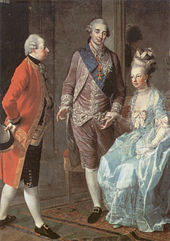From the outset, despite how she was portrayed in contemporary libelles, the new queen had very little political influence with her husband. Louis, who had been influenced as a child by anti-Austrian sentiments in the court, blocked many of her candidates, including Choiseul,[34] from taking important positions, aided and abetted by his two most important ministers, Chief Minister Maurepas and Foreign Minister Vergennes. All three were anti-Austrian, and were wary of the potential repercussions of allowing the queen – and, through her, the Austrian empire – to have any say in French policy.[35]

Archduke Maximilian Francis of Austria visited Marie Antoinette and her husband on 7 February 1775 at the Château de la Muette.
Marie Antoinette's situation became more precarious when, on 6 August 1775, her sister-in-law, the comtesse d'Artois, gave birth to a son, the duc d'Angoulême (who later became the presumptive heir to the French throne when his father, the comte d'Artois, became King Charles X of France in 1824). This resulted in release of a plethora of graphic satirical pamphlets, which mainly centered on the king's impotence and the queen's searching for sexual relief elsewhere, with men and women alike. Among her rumored lovers were her close friend, the princesse de Lamballe, and her handsome brother-in-law, the comte d'Artois, with whom the queen had a good rapport.[36]
This caused the queen to plunge further into the costly diversions of buying her dresses from Rose Bertin and gambling, simply to enjoy herself. On one famed occasion, she played for three days straight with players from Paris, straight up until her 21st birthday. She also began to attract various male admirers whom she accepted into her inner circles, including the baron de Besenval, the duc de Coigny, and Count Valentin Esterházy.[37]
She was given free rein to renovate the Petit Trianon, a small château on the grounds of Versailles, which was given to her as a gift by Louis XVI on 15 August 1774; she concentrated mainly on horticulture, redesigning in the English mode the garden, which in the previous reign had been an arboretum of introduced species. Although the Petit Trianon had been built for Louis XV's mistress, Madame de Pompadour, it became associated with Marie Antoinette's perceived extravagance. Rumors circulated that she plastered the walls with gold and diamonds.[38]
"...the innovativeness of Marie Antoinette's country retreat would attract her subjects’ fierce disapproval, even as it aimed to bolster her autonomy and enhance her prestige," (Weber 132).
An even bigger problem, however, was the debt incurred by France during the Seven Years' War, still unpaid. It was further exacerbated by Vergennes' prodding Louis XVI to get involved in Great Britain's war with its North American colonies, due to France's traditional rivalry with Great Britain.[39]
In the midst of preparations for sending help to France, and in the atmosphere of the first wave of libelles, Holy Roman Emperor Joseph came to call on his sister and brother-in-law on 18 April 1777, the subsequent six-week visit in Versailles a part of the attempt to figure out why their marriage had not been consummated.
It was due to Joseph's intervention that, on 30 August 1777, the marriage was officially consummated. Eight months later, in April, it was suspected that the queen was finally pregnant with her first child. This was confirmed on 16 May 1778.[40]

No comments:
Post a Comment